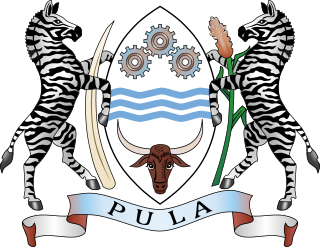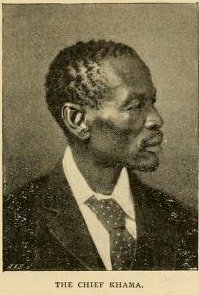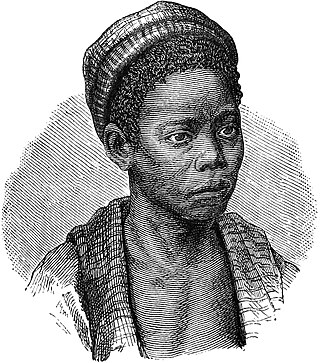Related Research Articles
The Batswana, a term also used to denote all citizens of Botswana, refers to the country's major ethnic group. Prior to European contact, the Batswana lived as herders and farmers under tribal rule.

The Government of Botswana often abbreviated as GOB, is the union government created by the constitution of Botswana having the executive, parliament, and the judiciary. The Seat of the Government is located in Gaborone, Botswana. The government is led by the president.

Khama III, referred to by missionaries as Khama the Good also called Khama the Great, was the Kgosi of the Bangwato people.

The Tswana are a bantu ethnic group native to Southern Africa. Ethnic Tswana made up approximately 85% of the population of Botswana in 2011.
The Bakwena or Bakoena are a large Sotho-Tswana clan in Southern Africa of the southern Bantu group. They can be found in different parts of southern Africa such as Lesotho, Botswana, South Africa and Eswatini. "Kwena" is a Sotho/Tswana/Sepedi word meaning "crocodile", the crocodile is also their totem (seboko).
Barolong is a tribe of Tswana people from Botswana and South Africa. Their King, Tau was the descendant of King Morolong who is the founder of Barolong tribe. He reigned around 1240 and adopted Tholo as the Barolong totem. King Tau was a warrior king who reigned around 1660. He fought many battles and consolidated the Barolong tribe to become a very strong kingdom. He had many wives and begot many sons and daughters. The prominent four sons are Ratlou, Tshidi, Seleka and Rapulana. The Barolong tribe later used the names of the warrior King Tau's sons as their clan names. The Barolong tribe spread across the regions covering Botswana, through to Transvaal, Northern Cape and Free State. Its important to note that King Tau’s heir to the throne was Ratlou. After the death of King Tau in Taung, a village in the North West province of South Africa which was named after Kgosi Tau, Barolong left Taung under Nthua, the younger brother of Tau. They settled in Dithakwaneng, and later, Dithakong, where Nthua died and was buried. Ratlou and the tribe left Dithakong for Mamusa, and later settled in their former capital i.e. Setlagole. This is the place where the kingship of Barolong disintegrated into a number of clans, after Tau's sons. This is after the death of Ratlou. Ratlou had four sons i.e. Mariba, Seitshiro, Mokalake and Moirwagale. Two of these sons fought for the throne, with Mokalake supporting Mariba while Moirwagale supported Seitshiro. Moirwagale became the Regent for Seitshiro while Mokalake became one for Mariba. Finally Barolong disintegrated into four clans, and later five. Their final settlements are as follows; Ratlou; Mariba (Ganyesa); Seitshiro (Khunwana); Tshidi and Makgetla-Mahikeng; Seleka-Thaba nchu; Rapulana-Bodibe.
Moshupa is a large village in the Southern District of Botswana with a population of 20,016 per the 2011 census. The people of Moshupa are called the Bakgatla-ba-ga Mmanaana, a group also found in Thamaga. Along with the related Bakgatla-ba-ga Kgafela of Mochudi, they arrived to the region from the Transvaal region in South Africa throughout the eighteenth century.

The Sotho-Tswana, also known as the Sotho or Basotho, although the term is now closely associated with the Southern Sotho peoples are a meta-ethnicity of Southern Africa. They are a large and diverse group of people who speak Sotho-Tswana languages. The group is predominantly found in Botswana, Lesotho, South Africa, and the western part of Zambia. Smaller groups can also be found in Namibia and Zimbabwe.

Gaborone was a kgosi (King) of the Tlokwa, a tribe of the larger Tswana people in what is now Botswana. He became the tribe's King around 1880, after the death of his father, and secured the Tlokwa's status as the "smallest independent tribal unit" in the Bechuanaland Protectorate. He gave his name to the city of Gaborone, Botswana's current capital.
Gagoangwe was the Acting (Regent) King, the Queen Mother or Mohumagadi of the Mmanaana Kgatla and BaNgwaketse in what is now Botswana. Gagoangwe was a member of the Kwena family and a devout Christian and regent for her grandson, Bathoen II.
Bathoen I was a kgosi of the Ngwaketse people (1889-1910). Together with Khama III and Sebele I he is credited with saving the young British Bechuanaland Protectorate, a predecessor of Botswana, from being absorbed by expansionist forces in the 1890s.
Elizabeth Pulane Moremi was regent and mohumagadi (queen) of BaTawana from 1946 to 1964 while her son, Letsholathêbê II a Morêmi, was too young to rule. She married Moremi III, the ruler of BaTawana, in 1937. When he was killed in a 1946 car crash, she was made regent. As regent, Moremi attempted to make several progressive reforms, but was hindered by conservative opposition. She stepped down in 1964 and worked at a school before her death thirty years later.
Tsheko Tsheko was a Motswana politician. He was a member of the National Assembly of Botswana from 1965 to 1969, where he served in the Cabinet of Botswana.
The History of Botswana includes its pre-state history, its colonial period as the Bechuanaland Protectorate, and its modern history as a sovereign state.
Sechele II Kealeboga Sebele was kgosi of the Kwena tribe in the Bechuanaland Protectorate from 1911 until his death in 1918. His rule was marked by a split within the tribe as opposing dikgosana led by his uncles rejected his authority. Sechele II was succeeded by his son Sebele II.
Motswasele II was the kgosi of the Kwena tribe from c. 1805 until his death c. 1821.

Kelebantse Sebele II (1892–1939) was a kgosi of the Kwena tribe in the Bechuanaland Protectorate. He ruled from 1918 until he was deposed by the British colonial administration in 1931. He was preceded by his father, Sechele II, and succeeded by his brother, Kgari Sechele II.
Seitlhamo was a kgosi of the Kwena tribe. He ruled from the death of his father Motswasele I c. 1785 until his own death c. 1795. He was succeeded by his son Legwale.
Maleke was a regent of the Kwena tribe. He was the son of kgosi Seitlhamo and the younger brother of kgosi Legwale. Maleke became regent of the Bakwena after Legwale died c. 1798. As kgosi, Maleke led an attack against a Bangwaketse village in Kanye to avenge the death of his father. He burned the village, and he is said to have killed Tawana, the uncle of the village's leader, Makaba. A short time later, Maleke died of rabies after he was bitten by a dog. He was succeeded as regent by his younger brother Tshosa until Legwale's son Motswasele II became kgosi c. 1805.
Tshosa was a regent of the Kwena tribe from 1803 to 1807. He became regent following the death of his brother Maleke, who was also a regent, and he held the position until he passed it to the Kwena heir, his nephew Motswasele II. After Motswasele's death, Tshosa led a group of the fractured Kwena tribe. He was killed in an attack by the Bakololo.
References
- de Jongh, M.; de Beer, F. C. (1992). "A case of ambiguous identity - oral tradition and the Ba ga Seleka of Lephalala". South African Journal of Ethnology. 15 (4): 101–108. ISSN 0379-8860.
- Morton, Fred (2011). "Bogwera and Mephato". Botswana Notes and Records. 43: 38–51. ISSN 0525-5090. JSTOR 23237955.
- Okihiro, Gary Y. (1976). "Genealogical Research in Molepolole: A Report on Methodology". Botswana Notes and Records. 8: 47–62. ISSN 0525-5090. JSTOR 40979457.
- Schapera, I (1980). "Notes on the early history of the Kwena (Bakwena-bagaSechele)". Botswana Notes and Records. 12: 83–87. ISSN 0525-5090. JSTOR 40980796.